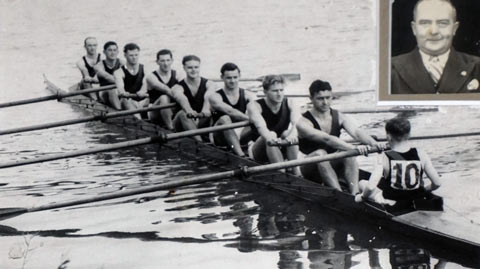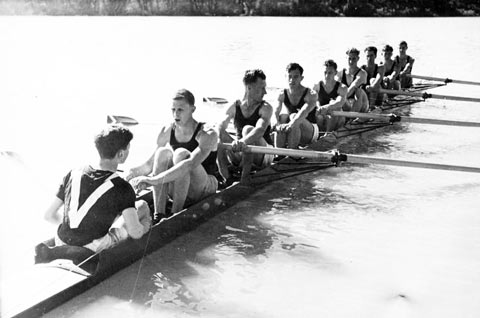History of Essendon Rowing Club, 1880-1980
Table of Contents
Chapters
- The Origins of the Sport
- The Development of the Sport
- The Founding of the Club - 1880-89
- Inter-club Competition - 1890-99
- Federation and Senior Success - 1900-09
- The War Years - 1910-19
- Recovery from the War - 1920-29
- Jubilee Year and Beyond - 1930-39
- Another War, Another Recovery - 1940-49
- Junior Sucess Again - 1950-59
- Senior Rise to the Top - 1960-69
- The New Clubhouse - 1970-79
Appendices
9. Another War, Another Recovery 1940-1949
With the outbreak of World War II and compulsory military training, the Club had only one oarsman from the 1939 Maiden Eight crew available to contest in 1940. A concentrated effort was made to increase membership. Messrs. Kenny, Muir, Schroder and O'Brien were appointed to approach the local Technical and High Schools to encourage interest and enthusiasm in rowing amongst the students. The Sports Master at the Technical School followed this up and the Committee in appreciation entered a motion of thanks in their minutes ..."We believe that this innovation will considerably benefit our Club and help fill our depleted ranks." Members increased to 71 during this season.
Club races increased to four this season. Ray Tucker won the Senior Sculls at Henley against inter-state competition. The majority of country and metropolitan regattas were cancelled; on June 6th 1940, a "V.R.A. delegate suggested a Time Trial Competition be introduced as all Pennant and Championship races were suspended. All clubs were instructed to make their own arrangements for inter-club races; and it was decided to discontinue the King's Cup competition for the duration of the war.
The Club suffered some disruption in the training program with the extension of the tram service across a temporary bridge erected over the Maribyrnong to the Cordite works … "the coaches and coxswains had a difficult task in negotiating the nasty turn caused by the pylons."
Essendon Rowing Club gained victory in the Challenge Fours held at Henley on the Maribyrnong and Yarra early in 1941 and they won the Maiden Four at Nagambie. A number of charity run Challenge Four races were held and two Club races - the J .H. Brown Pairs and the Opening Day Four races which were sponsored by Young and Jackson. Mr. Ryan indicated when presenting the Young and Jackson Cup that this would be an annual event. A Patriotic carnival and two dances were organized to support the 'supreme cause' and the Committee made the clubhouse and the boats available to the R.A.A.F stationed at the Showgrounds. These servicemen competed in regattas held early in the 1940-41 season.
The Club had a socially successful season, dances were held every third Saturday, and the profits totalled £138.0.0. Their first picnic was held at Hanging Rock on Sunday, January 14th.
It was decided at the A.G.M. on May 15th 1941 that canteen orders to the value of £1.0.0 would be sent to Digger members for Christmas. Members asked the Committee to form a Table Tennis Club and to improve the existing social activities.
The war restrictions affected the Club during the following season, especially the social functions. Reports of members Howard Roberts killed in action and Keith Pettman taken and imprisoned in Germany was gravely received. Early in 1942 canteen orders of £1.1.0 were sent to members in combat and the same amount was sent to Pettman's parents to forward a parcel to him on behalf of the club.
There were no additions to the fleet this season but a good deal of thought and discussion was spent on the type of rowlock to be adopted by the club.
The races contested were virtually those held within the Club; an invitation was extended to Albert Park Rowing Club to attend the Opening Day Fours and the Hawthorn Rowing Club accepted the invitation to compete in the Muir and Watson Fours.

Farewell to members heading off to WWII – March 1942
Left top right – Harry Hicks, Keith Anderson, Jack Doyle, Herbert Browne. Left second row – Arthur Groves. Right second row – (seated) Jack Swallow, Russ Gilchrist, Norm Muir, L. Curnow Snr., ?, D Casey, A. H. Tucker. Bottom row (left to right) – Wally McLean, Ted Worrall, (two Airforce visitors), Jack Austin, Gordon Tyshing, Wally White, Wally Bartling, Geoff Rae, Frank Johnson, Fred Gathercole, Harry McRae, Jim Doyle, Jack Brenna, E Edney, George Harrison, Reg “Puffer) Sawyer, Cotter James, ?, Bill Bendon, Don Pout, Bill “Cocky” O’Brien
Membership increased to 92; 22 of these were active service - senior members totalled 38, junior members 6 and Honorary members 16. Subscriptions were suspended for the members whilst on active service. Combination races were very popular this season, and throughout the duration of the war. The Young and Jackson Four's were adapted to combination races over this time.
The only success in inter-club competition was at the Novice Pair Regatta in April 1943. It was interesting to note that the Treasurer reported a credit balance - the first since the Depression.
Colours were well represented at every rowing fixture throughout the 1943/44 season and members met these with good measure. Essendon won two Challenge Pairs in December and January and a Novice Pair at the V.R.A. regatta in February. Four Club races were held, two of these combination races - this was the last year the J.R. Brown Pairs were conducted as J.R. Brown passed away early 1943. A .P. Watson died also this year.
The Essendon River League failed to organize Henley on the Maribyrnong this season.
On June 4th, the Committee transferred substantial amounts from the General Account to the Building Extension Fund and from the Library account to the Boat Replacement Fund, and between the two £300 was put under fixed deposit for twelve months.
At the A.G.M., W.E. O'Brien was elected a Life Member.
The club remained financially and socially successful during 1944-45 but most aspects of rowing was quiet. Several wins were scored early in the season - a double in the Lightweight Novice Four at the Metropolitan Regatta and at the Beauford RAAF Regatta. The club fours were staged - the first since the outbreak of the war; the trophies were donated by Doyle and Austin. The Young and Jackson Combination Fours had a record number of competitors totalling 108.
The Metropolitan Rowing Association instigated some new races - the novice Eight mile which was held on May 7th 1945, and they introduced two new sculling races - the 2000 metre and the mile.
Membership had increased to 113. £100.0.0 was placed under fixed deposit with the other already there and a rowing machine was bought from N. Berwick for £5.0.0.
At the end of the war, the V.R.A. resumed the Premiership in only one division. Essendon scored some wins at inter-club regattas but were unsuccessful in the premiership. They won the perpetual Moonee Valley Challenge Four's at Henley on the Maribyrnong.
As members returned from active service a sub-committee was elected to organize the acquisition of new boats, and on September 6th 1945 an order was placed for two tub pair oared boats, two practice four oared boats and one practice eight oared boat. On November 1st a resolution was passed, … "that in future any new boat purchased be fitted with fixed poppets and that the Club's policy in this direction would be in favour of fixed poppets".
Canteen orders were cancelled for the 1945 Christmas, and these funds were used for a Welcome Home Social. This was held on April 13th and returned servicemen from the Royal Australian Navy, the Australian Infantry Force, the Royal Australian Air Force, and one member from the New Zealand Expeditionary Force attended.
The Essendon Branch of the R.S.S.A.I.L.A. made a donation to the Club to perpetuate the memory of the late Harry Nelm. This took the form of a trophy for a Club competition - based on a points system - two for a regatta win, one for a club win, one for a combination win and half for contesting unsuccessfully. This cup was won by R. Bridger.
Victories during the 1946-47 season were disappointing. The Number 2 crew had success and won the Moonee Valley Challenge Fours at Henley on the Maribyrnong. The Club now retained the Cup after this third win. The Club procured a new plywood practise eight from the V.R.A. for £275.0.0 on January 9th 1947 and was named "Orm Copas" in memory of a former member and coxswain who will killed in action at New Britain in 1942. Earlier in the season his parents Mr. & Mrs. W.A. Copas had offered a trophy to the most successful coxswain, in honour of their son. Points were allocated for this award as follows - two for a regatta win, one for a club combination race win, and half for competing in a final “Providing the event being decided comprises heats and finals". The first coxswain to receive this trophy was Noel Buzalyo.
At the A.G.M. H.J. McRae was elected Life Member of the, Club.
In the following season the Club had scored better in competition. They won the Maiden Eight at the V.R.A. Regatta and at Albert Park. The Maiden Four too were victorious at the latter.
The Club had a number of damaged boats this season. During the Junior Eight Championship race the boat was swamped by a wave and although the crew valiantly continued with a broken seat, the backwash from a passing motor boat capsized the craft properly, breaking it into two. Also the Racing Four the "J. Nicholaisen" was damaged in training.
Subscriptions were altered during both the 1947-48 and 1948-49 seasons, adjusting them to current economic levels - which resulted in £3.0.0 for senior members, £2.0.0 for a junior (under twelve months membership) and £1.10.0 for an honorary member.
The Club finished third in Junior Premiership racing, winning the State Junior Eight for the first time since 1934, the Junior Eight double at Melbourne and Henley regattas late in 1948 and the Junior Fours at Nagambie on Boxing Day. The Junior Eight crew then contested in the Grand Challenge Cup to be narrowly beaten by Melbourne in the final. Essendon took out all the honours at Henley on the Maribyrnong winning both the Challenge Fours and Pairs.

1949 Champion Junior Eight
Bow: G Dundas, 2: G Tyshing, 3: J C Doyle, 4: D A Dodds, 5: D H Brook, 6: L Soderstrom, 7: J R King, Str: H Firth, Cox: J Tatterson, Cch: T L Mannix
J. King was selected to row in the Victorian crew to race at Murray Bridge in the King’s Cup race.

1949 Victorian Crew
Bow: Bill M Wallace, 2: Herb P Shears, 3: J R King, 4: S G A Thomas, 5: Murray A Christie, 6: Laurie L B Moll, 7: Tom G Hoffman, Str: Joe J F Goddard, Cox: David R Salmon
The boats christened during the season were the racing eight oared "Reg Barnes" in memory of R.G. Barnes who had lost his life as a prisoner of war in Malaya. The tub paired oared crafts “H. J. McRae” and the “W.E. O’Brien” were named after those prominent office bearers. The new racing eight which replaced the "A.P. Watson” was named "T. Mannix” after the man who had coached a great number of 'eight' crews to victory.
The Committee revised its decision on rowlocks and 10 matt wood swivels·- enough to fit out one boat - were purchased. This was the beginning of the end of the fixed poppets.
C. Chalmers and G. Harrison organized the first Christmas Tree celebration for member’s children to take place instead of the annual Christmas Gathering.
